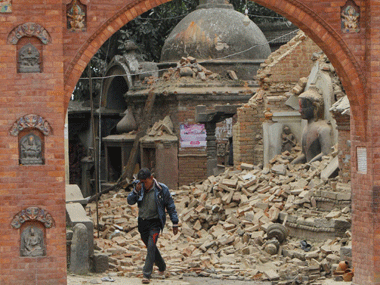The Earthquakes in Nepal can be termed as more than devastating. One of the least privileged countries of Asia has faced the worst wrath of nature which is far from over. The country that holds a large number of heritage sites has been reduced to debris and tourism, which was its strongest industry, was already at a disadvantage, will perhaps take a few years to recover.
The biggest threat that the country faces with more aftershocks to come is the breakout of epidemics. There are strong chances of Cholera and measles outbreaks. Hospitals are really not in a position to handle anything more than they already are. The number of injuries are rising and hospitals are making arrangements for patients to be treated outdoors not indoors in fear of entrapment when another quake appears. The number of fatalities has reached to 3, 218 and injuries recorded so far have been 6,538.
Tourists from more than 30 countries were held in Nepal when the earthquake struck. The Embassies of Japan has confirmed one of its citizens dead, France tracked 1,098 of its citizens, but another 674 have still to be found. Australia too is trying to find its 549 citizens who had travelled to Nepal. 200 have been traced and news on others is yet to come. Nearly 600 Israeli citizens were travelling to Nepal till now whereabouts of 400 have been received.
There has been concern from all parts of the world and neighboring countries of India and China are sending social aid. Britain has announced £5 million worth of aid. Britain has sent a crew of seven international rescue members in a flight chartered by the British Department of International development to Katmandu. The convoy is also carrying four search dogs, medical support team and hazardous material specialist with 11 tonnes of kit including, torches, axes, ropes, search cameras and tents and stretchers. Pakistan, United States, Canada, the United Arab Emirates, Germany, France, Poland, Italy, Israel and Singapore also sent aid.
The UNWTO Secretary-General, Taleb Rifai has expressed his condolence and rendered full support to the nation. “I would like to convey to the families and friends of the victims, to the people and the government of Nepal, our heartfelt condolences and solidarity in this tragic moment.”
“Nepal is one of the world’s tourism success stories and UNWTO will work alongside the Nepalese people and authorities to ensure that tourism continues to be a pillar of the country’s socio-economic progress,” he added.
These are reassuring words in a time like this when the level of crisis seems to be mounting. People from all over the world are standing by and offering their prayers for the fear stricken country that stands ruined and ravished by the deadliest natural calamity that it had ever expected.
Nepal is an earthquake prone area as the ruminants of the prehistoric lakes, which covers almost 300 meter deep layer of black clay, just underneath the Kathmandu valley. A study conducted by the Netherlands-based International Institute for Geo-information Science and Earth Observation observes that when a severe earthquake strikes Nepal the region faces a soil liquification. The solid ground turns into a quick sand and absorbs everything above the ground.
According to skymetweather The 7.9 magnitude earthquake that hit Nepal on Saturday was the result of an ongoing collision of tectonic plates.
The Indus-Yarlung suture zone, lying in the southern border of Nepal, collided with the Eurasian plate some 40 million to 50 million years ago. Today, the Indian subcontinent lies on the Indus-Yarlung suture zone and the Eurasian plate includes most of Europe and Asia. This collision created the Himalayan mountain range.
When the India plate pushes its way towards Asia, immense pressure builds up at the point where the two landmasses meet. Consequently, one landmass slides above the other giving rise to a shock-wave called an earthquake.
The closer is the epicenter of the quake the larger the impact. The location of the quake also matters. Nepal being in the earthquake prone area has given way to high risers which has added to the impact of destruction faced by the country. The 7.9 quake has been recorded as the strongest on the Richter scale and has been the most powerful in the last 80 years. The quake was shallow occurring at a distance of 10 km from ground level which caused direct damage to human existence.
It was fearful time in the highest mountain of the world, The Everest. Avalanches left a number of climbers dead and missing, several are trapped and injured while rescue operations are underway. The base camp where the climbers had gathered for safety was not a safe place after all. Surrounded by high Himalayan peaks the place is most prone to avalanche when prolonged quakes occur. Mountaineers have related their most fearful experiences. Many climbers who were unhurt helped the injured by digging them out of the snow and turned dining tents to makeshift field hospitals. Continuous snowfall made matters worse. Climbers worked in shifts through the night looking after the injured until helicopters came in. There are climbers still held in camps 1 and 2 who have not been traces yet.
Among the dead is the Dan Fredinburg, an American executive at Google who had been posting updates about his adventures in Nepal on Instagram and Twitter.
Most shops in the capital were closed after the government declared a week long period of recovery. Only fruit vendors and pharmacies seemed to be doing business.




0 comments :
Post a Comment